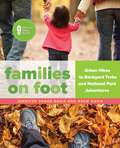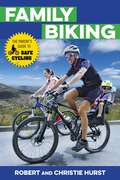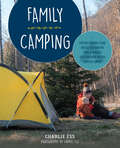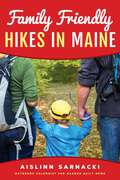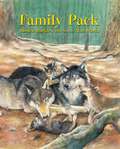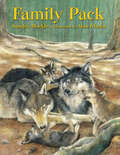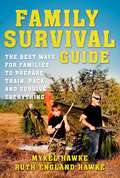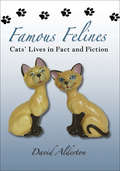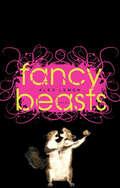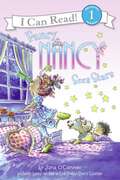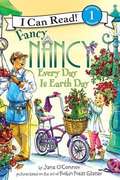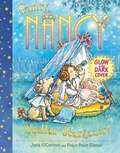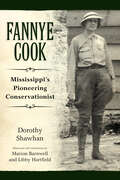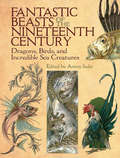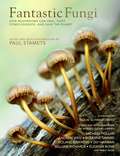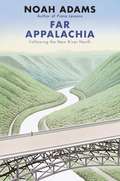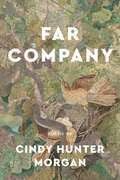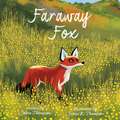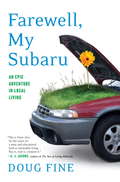- Table View
- List View
Families on Foot: Urban Hikes to Backyard Treks and National Park Adventures
by Jennifer Pharr Davis Brew DavisFamilies on Foot is an interactive guide for families to help motivate children to enjoy hiking and walking in nature. The progressive book would outline basic steps to help families with kids grow from beginner to intermediate hikers and to cultivate a love and enthusiasm for the outdoors. (Going beyond this to &“advanced hiker&” is beyond the scope of this book and the need for families.) Elements include a basic checklist of gear and safety needs, simple exercises for the whole family to prep for getting out on the trail, real life stories (perhaps crowdsourced from the AHS community), and ideas and activities for making the experience fun for kids of all ages. Chock full of aspirational color photography featuring diverse people and kids, the book is also practical in nature, offering information on gear checklists and how to use GPS, read a map, and predict weather before going out on the trail. It would feature experiences in everything from neighborhood parks to secluded trails. Additionally, the book reflects the hallmarks of the American Hiking Society, with whom we would work to make this book a success.
Family Biking: The Parent's Guide to Safe Cycling
by Robert Hurst Christie HurstFamily Biking is a guide for parents and parents-to-be on how to introduce their children to the joys and responsibilities of bicycle riding. The guide includes safe methods of transporting children via trailer bike or tandems, taking young children on bicycle tours, fitting a child to a bicycle, teaching all aspects of bicycle safety, as well as how to deal with dangerous or potentially dangerous situations. It also includes how to teach children to care for their own bicycle, how to dress, how to carry things on their bicycle, and how to perform basic maintenance and repairs.
Family Camping: Everything You Need to Know for a Night Outdoors with Loved Ones
by Charlie EssThe ultimate camping handbook—whether you&’re with family or friends, camping or in your backyard—Family Camping has everything you need for a perfect experience. Part inspiration, part practical knowledge, this book is a whole lot of fun. Family Camping offers up food and drink recipes, family activities, nature hacks, expert know-how, and more for the outdoor lover looking for a memorable weekend with the family. Each chapter opens with a first-person story from expert author, Charlie Ess, who has been camping and exploring the beautiful outdoors of his native Alaska for 40 years. With aspriational photos supplied by Cheryl Ess, Family Camping is a gorgeous, treasured keepsake for campers everywhere.
Family Friendly Hikes in Maine
by Aislinn SarnackiThe vast majority of visitors to Maine are not rugged outdoors types looking for adventure. Yet many of these people still want to enjoy a nice walk or short hike with their kids or parents. In this collection of hikes, Bangor Daily News outdoors reporter Aislinn Sarnacki presents dozens of hikes around the state that will let you experience the Maine wilderness, but won&’t leave you gasping for breath. Most are short (less than three miles), and all are in the easy/moderate difficulty range. Color photos inform you of trail details and some of the wildlife or scenery you may see on your hikes, and clear maps make sure you make it home for dinner. It&’s all rounded out with practical advice and information about access to public and private lands.
Family Pack
by Sandra MarkleThrough the shadows of snow-frosted trees, a young female gray wolf lopes. She is new to this place--to Yellowstone. Gray wolves haven't lived here in seventy years. This female is alone, without the comfort of her mother or other wolves. As the seasons change and the young female grows, she must learn to feed, to hunt, and to survive in her new home. She must make her own family pack.
Family Pack
by Sandra MarkleA real-life story of adaptation and survival. Acclaimed science writer Sandra Markle and celebrated artist Alan Marks team up for the fifth time in this fascinating real-life story of a wolf and her pack. Years ago, an effort had been made to eliminate wolves from Yellowstone National Park. Recently, conservationists decided to reintroduce the animal to the area, relocating wolves from Canada. Family Pack introduces readers to Female 7 and Male 2, the founders of the Leopold wolf pack—the first naturally formed pack after the relocation effort. Readers follow Female 7 as she sets out on her own upon her release to the 2.2-million-acre area that is Yellowstone. Without the comfort of her mother or other wolves, the young female grows and learns to feed, hunt, and survive in her new home. Eventually, she crosses paths with Male 2, and the wolves form a family of their own. Back matter includes more information about wolves, a bibliography, and an author’s note about the Leopold pack and the importance of reintroducing wolves to Yellowstone, restoring the natural balance.
Family Survival Guide: The Best Ways for Families to Prepare, Train, Pack, and Survive Everything
by Mykel Hawke Ruth England HawkeAre you prepared in case disaster strikes? Are your kids? In the Family Survival Guide, veteran adventurers Mykel and Ruth Hawke provide the vital information you and your family need to get through almost any disaster safely. The topics covered are wide-ranging and easy-to-follow. Here, you and your family will learn: How to find, purify, and store water How to construct different types of shelter and the perfect places to build them What to pack and what not to pack in a bugout bag Essential first aid skills How to navigate your way when lost How to build a fire Basic foraging, hunting and outdoor cooking skills And so much more! Filled with expert advice and time-tested tips, Family Survival Guide is an essential handbook
Famines During the ʻLittle Ice Ageʼ (1300-1800)
by Dominik Collet Maximilian SchuhThis highly interdisciplinary book studies historical famines as an interface of nature and culture. It will bring together researchers from the natural and social sciences as well as the humanities. With reference to recent interdisciplinary concepts (disaster studies, vulnerability studies, environmental history) it will examine, how the dominant opposition of natural and cultural factors can be overcome. Such an integrated approach includes the "archives of nature" as well as "archives of man". It challenges deterministic models of human-environment interaction and replaces them with a dynamic, historicising approach. As a result it provides a fresh perspective on the entanglement of climate and culture in past societies.
Famous Felines: Cats' Lives in Fact and Fiction
by David AldertonA delightful hiss-torical survey of cats in popular culture. Louis Wain and Beatrix Potter adored them, but Walt Disney preferred dogs; cats have been depicted in art, books and, more recently, film and TV as lovable but determined creatures. Where the dog is loving but stupid, the cat is clever but sly. Bestselling author David Alderton explores this myth and reveals just who the most famous cats are, including cartoon classics such as Top Cat, Felix, and the dastardly Si and Am from 101 Dalmatians. Using collectible memorabilia and original book covers, this charming book is a purr-fect stocking filler, along with its doggish counterpart, Famous Dogs by Fiona Shoop—ideal packaged together.
Fan-Tan
by Marlon Brando Donald CammellFan-Tan is a hugely entertaining, swashbuckling romp, from one of the greatest actors of our time: Marlon Brando. The story of an eccentric early-twentieth-century pirate who sets out on the high seas from the Philippines to Shanghai, Fan-Tan follows the exploits of Anatole "Annie" Doultry, a larger-than-life character that Brando could have easily inhabited himself. When Annie saves the life of a Chinese prisoner in a Hong Kong prison, he's led to the mysterious and seductive Madame Lai Choi San--one of the most notorious gangsters in Asia--and here the true adventures begin.Years in the making with Brando's longtime collaborator, screenwriter and director Donald Cammell, Fan-Tan is a rollicking, delectable tale--and the last surprise from an ever-surprising legend.From the Trade Paperback edition.
Fancy Beasts: Poems
by Alex LemonCalifornia wildfires, the 2008 election, plastic surgery, Larry Craig, wildfires, Wal-Mart, and rampant commercialism—in Fancy Beasts, Alex Lemon takes on American media culture, the obscene foil for personal legacies of violence and violation.The poems of this collection are a workout: vigorous and raw, frenetic and fearless. Yet they are also composed and controlled, pared down and sculpted, with a disarming narrative simplicity and directness. Even when dealing with toxic content—including the turning point in a life of abuse, in which the recovering victim/perpetrator puzzles through the paradigm of son-to-husband-to-father—Lemon&’s point of view is always genuine and trustworthy.A frank, funny, and inimitably frenetic vision of post-millennial America, Fancy Beasts is a stunning achievement from Alex Lemon.
Fancy Nancy Sees Stars (I Can Read Level 1)
by Jane O'ConnorNancy can hardly wait for her class visit to the planetarium in this Fancy Nancy story from the beloved New York Times bestselling author-illustrator team Jane O’Connor and Robin Preiss Glasser. Nancy absolutely adores stars. She loves how they sparkle in the sky, and she can even name the constellations. When she finds out her class will visit the planetarium she is ecstatic—that's a fancy word for excited. But when it starts to rain Nancy is afraid she might not be able to see the stars. Will the rain keep Nancy from watching stars sparkle?Fancy Nancy Sees Stars is a Level One I Can Read book, which means it's perfect for children learning to sound out words and sentences. The back matter features a list of the rich vocabulary words that are used throughout the story along with their definition.
Fancy Nancy: Every Day Is Earth Day (I Can Read! #Level 1)
by Jane O'ConnorBeing green is important to Nancy--so important that she wants her family to take care of the Earth morning, noon, and night!
Fancy Nancy: Stellar Stargazer! (I Can Read!)
by Jane O'Connor<P> Fancy Nancy thinks that everything in the sky is simply stellar, from the sun and the moon to the stars -and their constellations (that's 'a fancy word for the shapes that stars make!). So nothing could make her happier than a special sleepover under the stars with her dad and her little sister, JoJo. <P>Together Nancy and JoJo wish on stars, moon bathe, and even eat astronaut ice cream! But when rain clouds cover up the stars, what's a stellar stargazer to do? <P>Picture descriptions present.
Fannye Cook: Mississippi's Pioneering Conservationist
by Dorothy ShawhanMississippi Chapter of The Wildlife Society Outstanding BookConservationist Fannye Cook (1889-1964) was the most widely known scientist in Mississippi and was nationally known as the go-to person for biological information or wildlife specimens from the state. This biography celebrates the environmentalist instrumental in the creation of the Mississippi Game and Fish Commission (now called the Mississippi Department of Wildlife, Fisheries, and Parks) and the Mississippi Museum of Natural Science.To accomplish this feat, Cook led an extensive grassroots effort to implement game laws and protect the state's environment. In 1926 she began traveling the state at her own expense, speaking at county fairs, schools, and clubs, and to county boards of supervisors on the status of wildlife populations and the need for management. Eventually she collected a diverse group of supporters from across the state. Due to these efforts, the legislature created the Mississippi Game and Fish Commission in 1932. Thanks to the formation of the Works Progress Administration in 1935, Cook received a WPA grant to conduct a comprehensive plant and animal survey of Mississippi. Under this program, eighteen museums were established within the state, and another one in Jackson, which served as the hub for public education and scientific research.Fannye Cook served as director of the Mississippi Museum of Natural Science until her retirement in 1958. During her tenure, she published many bulletins, pamphlets, scientific papers, and the extensive book Freshwater Fishes of Mississippi.
Fantastic Beasts of the Nineteenth Century: Dragons, Birds, and Incredible Sea Creatures (Dover Fine Art, History of Art)
by Anton SederFanciful creatures slither, swim, and soar through this full-color adaptation of a rare 19th-century German portfolio. The colorful images include exotic birds and fishes, dramatic reptiles and amphibians, and scores of ferocious dragons. This new layout of a hard-to-find antique volume presents enlargements of the original illustrations that offer magnified details of stylized feathers, fins, scales, and other fantastic features. The tremendous variety of these images makes this volume a perfect resource for all manner of graphics and art reference. This meticulously reproduced collection of fanciful creatures represents the first republication of Anton Seder's bestiary since the original 1896 edition. The Munich-based painter is best known for Die Pflanze in Kunst und Gewerbe (The Plant in Art and Trade), which incorporated plants into decorative patterns, and Das Thier in Der Decorativen Kunst (Animals in Decorative Art), which similarly integrated animals and mythical dragons into ornamental motifs. Designers, artists, and crafters will appreciate Seder's imaginative works and their distinctive combination of outstanding designs with keen observations of nature.
Fantastic Fungi: Expanding Consciousness, Alternative Healing, Environmental Impact // Official Book Of Smash Hit Documentary
by Paul Stamets&“Louie Schwartzberg&’s lightly informative, delightfully kooky documentary, &“Fantastic Fungi,&” offers nothing less than a model for planetary survival.&” –Jeannette Catsoulis, The New York Times &“Gorgeous photography! Time-lapse sequences of mushrooms blossoming forth could pass for studies of exotic flowers growing on another planet.&” –Joe Morgenstern, The Wall Street JournalThe Life-Affirming, Mind-Bending Companion Book to the Smash Hit Documentary FANTASTIC FUNGI Viewed in over 100 countries and selling hundreds of thousands of tickets on the way to finishing 2019 with a rare 100% Tomato meter rating on Rotten Tomatoes, Schwartzberg&’s documentary Fantastic Fungi has brought the mycological revolution to the world stage. This is the film&’s official companion book, that expands on the documentary&’s message: that mushrooms and fungi will change your life– and save the planet. Paul Stamets, the world&’s preeminent mushroom and fungi expert is joined by leading ecologists, doctors, and explorers such as Michael Pollan, Dr. Andrew Weil, Eugenia Bone, Fantastic Fungi director Louie Schwartzberg, and many more. Together these luminaries show how fungi and mushrooms can restore the planet&’s ecosystems, repair our physical health, and renew humanity&’s symbiotic relationship with nature. Join the Movement: Learn about the groundbreaking research that shows why mushrooms stand to provide a solution to environmental challenges, a viable alternative to traditional medicine, and a chance to radically shift consciousness. Most Comprehensive Fungi book in the world: Admire the astounding, underappreciated beauty with over 400 gloriously-shot photographs of the mycelial world&’s most rare and beautiful species in their natural environment. World&’s Leading Fungi Experts: Edited by preeminent mycologist Paul Stamets, who contributes original pieces, Fungi includes original contributions by bestselling author and activist Michael Pollan, alternative medicine expert Dr. Andrew Weil, award-winning nature and food writer Eugenia Bone, Fantastic Fungi director Louie Schwartzberg, and so many more. The book&’s roster of experts make this the most comprehensive survey of the diverse benefits and extraordinary potential of these amazing organisms.
Far Appalachia: following the New River north
by Noah AdamsThe host of NPR's All Things Considered and bestselling author of Piano Lessons takes us on a river journey through the heart of Appalachia-a journey shared by pioneers and preachers, white-water daredevils, bluegrass musicians, and an unforgettable cast of vivid historical characters. Following the New River North, Noah Adams has Appalachia in his blood. A native of eastern Kentucky, he comes to the headwaters of the New River not just in search of adventure but to better understand his own unique heritage. Following the New River from its mile- high source on North Carolina's Snake Mountain to its West Virginia mouth, Adams travels by canoe and by bicycle, by foot and, most thrillingly, by white-water raft to explore the history, natural beauty, and fascinating characters waiting around every bend and turn.
Far Company: Poems By Cindy Hunter Morgan (Made in Michigan Writers Series)
by Cindy Hunter MorganIn Far Company, we hear Cindy Hunter Morgan thinking about the many ways we carry the natural world inside of us as a kind of embedded cartography. Many of these poems commune not only with lost ancestors but also past poets. We hear conversations with Emily Dickinson, James Wright, Walt Whitman, and W. S. Merwin. These poets, who are part of Hunter Morgan’s poetic lineage, are beloved figures in the far company she keeps, but the poems she writes are distinctly hers. Poet Larissa Szporluk remarked, "The poems in this collection are quiet and deceptively simple. My first response was to be amazed by a seeming innocence in delivery—straightforward, picturesque, and compassionate—that then matured like a crystal into something precious and masterful. We are left with the whole forest having met all the trees one by one. There is so much respect in this collection—respect for natural processes that include intergenerational relationships, shared territories, and myths." The poems in Far Company reveal a mind and a heart negotiating both self and world with compassion and invention. They are cinematic in the way they navigate loss, memory, dislocation, hope, and love—abstractions evoked in deeply specific and nuanced ways. There is the drone that flies over Hunter Morgan’s grandparents’ farm before the house burns and the stag-handled knife in a pocket, its single blade "folded inside like a secret" on a train in Greece. But this collection is full of quieter cinema, too—a grandfather bending to cinch the girth of a horse, days "green / with snap peas and wild tendrils," and "raindrops beading like sweat / on the lips of snapdragons." The root of this book is Hunter Morgan’s love for family and her love for the land her family has shared. These poems map a journey to many places, inward and outward, and engage with the natural world and the built world, moving between both of those environments in ways that acknowledge the complexities of such crossings. Often melancholic but never sentimental, this collection belongs with any reader who seeks out literature in the organic world.
Far from Land: The Mysterious Lives of Seabirds
by Bruce Pearson Michael BrookeThe lives and activities of seabirds as you’ve never seen them beforeSeabirds evoke the spirit of the earth's wildest places. They spend large portions of their lives at sea, often far from land, and nest on beautiful and remote islands that humans rarely visit. Thanks to the development of increasingly sophisticated and miniaturized devices that can track their every movement and behavior, it is now possible to observe the mysterious lives of these remarkable creatures as never before. This beautifully illustrated book takes you on a breathtaking journey around the globe to reveal where these birds actually go when they roam the sea, the tactics they employ to traverse vast tracts of ocean, the strategies they use to evade threats, and more.Michael Brooke has visited every corner of the world in his lifelong pursuit of seabirds. Here, he draws on his own experiences and insights as well as the latest cutting-edge science to shed light on the elusive seafaring lives of albatrosses, frigatebirds, cormorants, and other ocean wanderers. Where do puffins go in the winter? How deep do penguins dive? From how far away can an albatross spot a fishing vessel worth following for its next meal? Brooke addresses these and other questions in this delightful book. Along the way, he reveals that seabirds are not the aimless wind-tossed creatures they may appear to be and explains the observational innovations that are driving this exciting area of research.Featuring illustrations by renowned artist Bruce Pearson and packed with intriguing facts, Far from Land provides an extraordinary up-close look at the activities of seabirds.
Far, Far Away
by Molly Beth GriffinA picture book celebrating the beauty of nature, new experiences, and gaining perspective. Sometimes you have to go far, far away to appreciate the world around you.Excellent for fans of The Camping Trip and 3–7-year-olds with an interest in the outdoors will love the exploration of wildlife and its rewards.Mom and Mama are taking Rowan on his first camping trip far, far away from the city where they live. Rowan is excited to see all kinds of wildlife, possibly even a bear or a moose!But they are canoe camping, which means they carry all their supplies on their back and paddle from place to place. Before long, Rowan is tired and hungry, itchy from mosquito bites, and downright grumpy. In fact, he wants to go home.When night falls, Mom and Mama listen to his complaints, but when they show him the sky—full of stars like he's never seen before—Rowan realizes that though camping is hard work, it is worth it in the end.Young readers will have a better appreciation for the challenges and rewards that come with being in the outdoors, and will come back to Far, Far Away often to remind themselves of nature&’s beauty.
Far, Far The Mountain Peak
by John MastersFar, Far the Mountain Peak is a portrayal of twenty years in the life of Peter Savage, British civil servant and mountaineer. A man of ruthless will and ambition from his Cambridge days to his time of near glory in India, Peter Savage is determined to reach the top and his motto is 'at all costs'. Talented, brilliant, lonely, he wins the love of a woman who both understands and fears him, and he enjoys the loyalty and friendship of an English peer and Indian patriot. But this life and career are cold-bloodedly plotted so that the people close to him are essential to his design for fame and greatness, and he is indifferent to his destructive effect on them as human beings. A tragic revelation of his own false values is the turning point of his own life, and how he finds his way to self-redemption is the magnificent climax of the novel.
Faraway Fox
by Jolene Thompson Justin ThompsonAs Fox wanders through a strange landscape, he cannot help but be reminded—at every corner—of the streams, the trees, and the family he once knew. Fox would like nothing more than to return to his home, but it seems the cityscape has built up around him. Follow Fox as he looks for a way back home to the wild green land where every fox belongs. Back matter shows readers the creative ways humans are helping to mitigate habitat encroachment in our towns and cities.
Farewell, My Subaru
by Doug FineA journalist who contributes to National Public Radio recounts hardwon lessons he learned from trying to live a more sustainable lifestyle "with a minimum of hypocrisy. " Among Fine's mis/adventures on his Funky Butte ranch are: converting a truck to run on restaurant waste oil, defending his goats from predators, and installing solar panels. He agrees with Kermit the frog that being green isn't easy but remains committed. The book includes facts about our carbon footprint, Web resources, and several recipes.
Farm + Land's Back to the Land: A Modern Guide to Outdoor Life
by Freddie Pikovsky Nicole CaldwellA spectacular treehouse suspended above a lush forest. A cozy cabin perched on a mountainside. A small farm growing heirloom vegetables in the high desert. These are the extraordinary stories of the modern-day back-to-the-land-movement, a movement that embraces slow living, sustainability, and the value of doing things with your own two hands. Here are remarkable narratives, essential how-tos, and hundreds of breathtaking photographs from people who have embraced lives of adventure in wild places. Delivered in a handsome volume that inspires feelings of wanderlust, this book is a must-have for outdoor enthusiasts and anyone who has ever dreamed of escaping to a simpler way of life.
